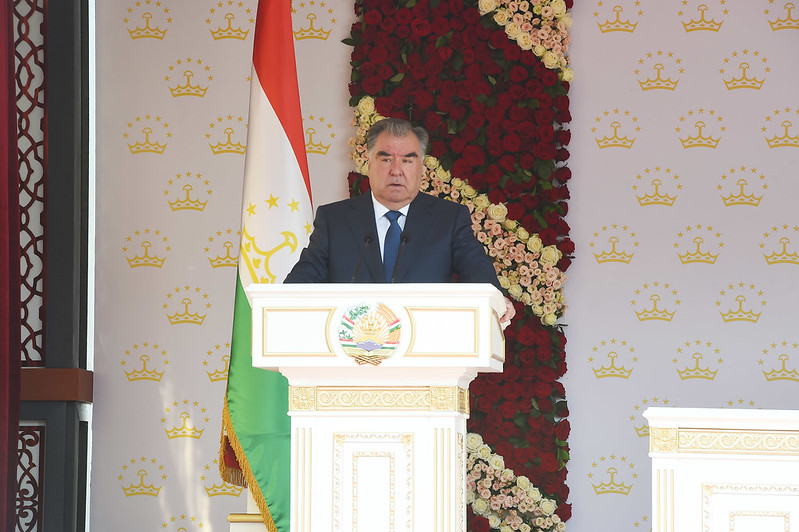“Once again I remind residents of Isfara that they must live and work with their neighbors in an atmosphere of mutual understanding and neighborliness, communicate with them and establish friendly cooperation, be tolerant and not succumb to emotions,” Tajik President Emomali Rahmon said.
His call, directed at residents of Isfara, came during an address to a meeting of Isfara administrators and public activists that took place in the northern city of Isfara on April 17.
“As the proverb says, neighbors are not chosen,” Emomali Rahmon was cited as saying by its official website.
 ИЗОБРАЖЕНИЕ
ИЗОБРАЖЕНИЕ
He further noted that solution of border-territorial issues, delimitation and demarcation of disputed segments of the border are a very complex process and take a lot of time and require many efforts.
“Tajikistan is a firm support of negotiations to find a mutually beneficial solution to existing problems, taking into account the national interests of both parties. I emphasize again that borer issues between nations can be resolved only through negotiations, there is no other way,” Tajik leader said.
Rahmon also noted that it should not be forgotten that “We, the Tajiks, one of the oldest nations in the world, throughout the long history have addressed all emerging problems and issues wisely, with restraint and patience.”
 ИЗОБРАЖЕНИЕ
ИЗОБРАЖЕНИЕ
As it had been reported earlier, a shootout between Tajik and Kyrgyz border guards took place along the Tajik-Kyrgyz border took place on April 12. The incident occurred Tuesday (April 12) evening near the Khistevarz jamoat in the Bobojon-Ghafourov district of the Tajik northern province of Sughd.
As a result of the shootout, a 27-year-old Tajik border guard Zoir Saidumarov was fatally wounded; he died the same day at a hospital.
According to Kyrgyz sources, two Kyrgyz border guards and four Kyrgyz civilians were also wounded in the incident.
Tajik and Kyrgyz delegations met on April 13. The parties agreed to withdraw troops to permanent deployments, find out the causes of the incident and reached agreement on security, land tenure and irrigation issues. The negotiations ended with signing of an appropriate protocol.
On April 14, Tajik and Kyrgyz foreign ministers held a phone talk to discuss the situation along disputed segments of the border between the two nations after the April 12 deadly shoot-out involving border guards.
The latest shootout took place just weeks after border guards from the two sides exchanged fire on March 10. According to a resident of Tajikistan’s Chorkuh jamoat, one Tajik border guard was killed and two others wounded then.
In late January, clashes erupted along a segment of the two countries' poorly demarcated border in a standoff over a blocked road.
Tajikistan's State Committee for National Security said at the time that two civilians were killed and 10 other people — six security force members and four civilians – were wounded.
Kyrgyz authorities said 12 Kyrgyz nationals were seriously wounded and more than 24,200 Kyrgyz citizens were evacuated from the area because of the fighting in January.
In April 2021, clashes involving military personnel along the Tajik-Kyrgyz border left dozens of people dead on both sides.
The border of Kyrgyzstan and Tajikistan has been the scene of unrest repeatedly since the collapse of the former Soviet Union.
It has been difficult to demarcate the Kyrgyz-Tajik border because over the course of some 100 years Soviet mapmakers drew and redrew the Kyrgyz-Tajik border, incorporating land that had traditionally belonged to one people in the territory of the other Soviet republic.
Exclaves appeared and temporary land use agreements were signed.
All of this survived the collapse of the Soviet Union and people in Kyrgyzstan and Tajikistan have various Soviet-era maps they use to justify their claim to specific areas along the border.
Border talks between Tajikistan and Kyrgyzstan began in 2002. Only slightly more than half of the 970 kilometers of border shared by the two countries has been demarcated despite decades of attempts to bring the matter to a close. The border delineation problem has led to conflicts between rival ethnic communities.
To-date, Tajikistan and Kyrgyzstan have held more than 170 meetings and negotiations on delimitation and demarcation of the common border.




